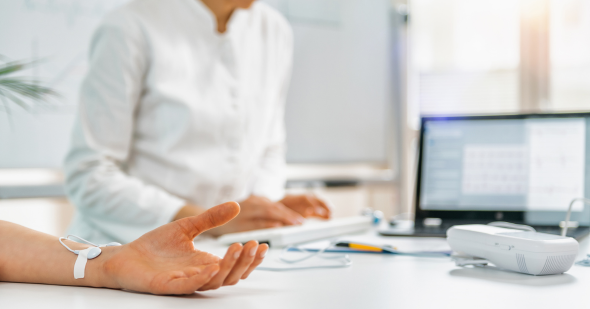Biofeedback Therapy
The purpose of biofeedback therapy is to, first, understand the mind and body connection, and second, to understand the control you have or don’t have over your heart rate, breathing patterns, and muscle responses. An example is your body’s fight-or-flight response. When you get scared, your adrenaline kicks in and your heart rate rises. That is your body getting itself ready for action. Now it is time to learn how to control it.
Biofeedback therapy empowers people to enhance their overall well-being by fostering self-awareness and self-regulation. Through guided sessions and real-time feedback, individuals develop skills to manage stress, anxiety, and muscle tension. At Legacy Healing Center, this technique is integrated into comprehensive treatment plans to support individuals on their journey to recovery and holistic wellness.
What Is Biofeedback Therapy?
Biofeedback is a therapeutic technique designed to help individuals gain control over involuntary bodily functions. By using electronic sensors to monitor physiological responses like heart rate, muscle tension, and skin temperature, patients can learn to recognize and regulate these functions.
Types of Biofeedback Therapy Training
There are several different types of biofeedback therapy training techniques. Depending on what you need or the goals you have in mind for therapy, you can use one or a combination of them.
- Breathing: In breathing biofeedback sessions, bands encircle your stomach and chest, with sensors monitoring your breathing rate and patterns. This enables you to actively regulate your breathing, leading to improved well-being and a sense of control.
- Brain Waves: In this form of biofeedback, an electroencephalograph (EEG) utilizes scalp pads to track your brain waves, which correspond to various mental states like relaxation, wakefulness, and sleep. Through biofeedback therapy, you can observe shifts in these brain waves that contribute to improvement in your overall health.
- Heart Rate: In this biofeedback method, pads are positioned on your chest, lower trunk, or wrists, linked to an electrocardiogram (ECG) to monitor your heart rate and its fluctuations. Additionally, a sensor may be attached to your finger to gauge your heart rate. Relaxation often coincides with a decrease in heart rate.
- Muscle Activity: An electromyograph (EMG) machine employs sensors to detect muscle tightening, aiding in the awareness of muscle tension and facilitating steps toward its control.
- Sweat Gland Activity: Sensors affixed to the fingers, palm, or wrist gauge the activity of sweat glands, providing insight into nervousness based on the level of perspiration on your skin.
- Temperature: Sensors placed on your fingers or feet monitor blood flow to your skin. Stress commonly leads to a drop in temperature, so a low reading may signal the need for relaxation techniques. As you relax, you may notice warmer sensations in your fingers and toes.
The Purpose of Biofeedback Training
Biofeedback therapy serves as a powerful tool with the overarching purpose of empowering individuals to take control of their physiological responses for improved health and well-being. At its core, biofeedback therapy aims to enhance self-awareness by providing individuals with real-time information about their bodily functions, such as heart rate, muscle tension, skin temperature, and brainwave activity. By gaining insights into these physiological processes, individuals learn to recognize and understand the intricate connection between their thoughts, emotions, and bodily reactions.
One primary purpose of biofeedback therapy for anxiety is stress management and relaxation without anti-anxiety medication. By monitoring physiological indicators of stress, such as elevated heart rate and muscle tension, individuals can learn relaxation techniques to reduce stress levels and induce a state of calmness. Through repeated practice and feedback, they develop the skills needed to mitigate the effects of stress in their daily lives, promoting greater resilience and emotional well-being.
Another key purpose of biofeedback therapy is pain management. By understanding how their thoughts and emotions influence their perception of pain, individuals can learn techniques to modulate their pain response. Biofeedback therapy has been particularly beneficial for individuals with chronic pain conditions, offering a non-pharmacological approach to pain relief that can complement existing treatment strategies.
Lastly, biofeedback therapy can be instrumental in improving mental health outcomes. By targeting physiological markers of anxiety, depression, and other mood disorders, individuals can learn to regulate their emotional responses and develop healthier coping mechanisms. Neurofeedback therapy, a specific form of biofeedback therapy that focuses on brainwave activity, has shown promising results in enhancing mood regulation and cognitive function.
The Benefits of Biofeedback Therapy
Biofeedback therapy presents a holistic approach to wellness, offering transformative benefits across various domains. Through real-time interpretation of physiological responses, individuals can effectively manage stress levels and induce relaxation using techniques such as deep breathing and muscle relaxation. It provides a non-pharmacological avenue for chronic pain management by teaching individuals to modulate pain perception.
This therapy cultivates enhanced self-awareness, enabling individuals to recognize early signs of stress and intervene proactively to restore balance. In addressing mental health concerns like anxiety, depression, and PTSD, biofeedback regulates emotional responses and enhances mood regulation and cognitive function. Its tailored treatment plans ensure personalized strategies for optimal outcomes, empowering individuals to thrive in all aspects of life. Biofeedback therapy encourages individuals to actively engage in their health journey, unlocking the body’s innate wisdom for holistic well-being.
Building a Brighter Future, Together
At our behavioral health treatment facilities, we believe everyone deserves a chance to flourish. Our team understands the power of recovery firsthand. We leverage our combined experience and a proven holistic approach to not just manage addiction and mental illness, but help you thrive. We specialize in biofeedback therapy and want to help you with an approach that’s tailored to your needs. Legacy Healing Center can be your guide.
Our national rehabilitation centers offer a range of services designed to support your recovery journey, motivating you to build a life of wellness and fulfillment. Contact us today to explore personalized treatment options and take the first step toward a brighter future. If you would like to learn more about what we do at Legacy, read our treatment articles.
Related Readings
How to identify the signs of psychological addictions with our help.
Outpatient Rehab Lets You Continue With Responsibilities Like Work, School, and Family




